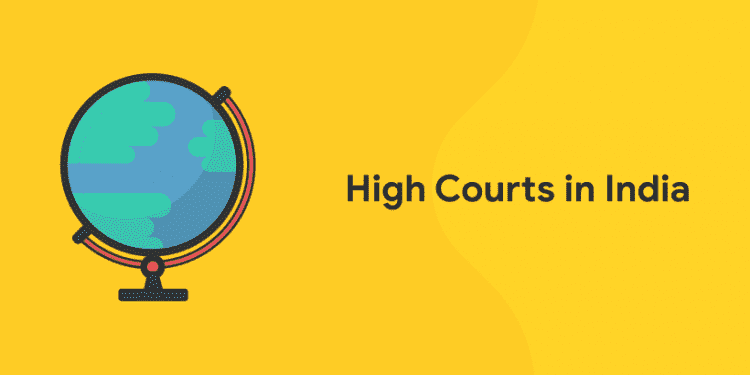Indian Polity plays an integral part of the syllabus of any exam and quite often there is a question about the India’s Judicial system. Here is an overview of the High Courts of India. The Judicial system in India comprises of the Supreme Court and the 25 High Courts in India.
Download Entri to gain access to all the previous years questions and to the wealth of information it has to offer.
Important Highlights of the High Court of India
- Judges in a high court are appointed by the President of India in consultation with the Chief Justice of India and the Governor of the state.
- High courts are headed by a chief justice. The chief justices rank fourteenth (within their respective states) and seventeenth (outside their respective states) on the Indian order of precedence.
- The number of judges in a court is decided by dividing the average institution of main cases during the last five years by the national average, or the average rate of disposal of main cases per judge per year in that High Court, whichever is higher.
- The jurisdiction of each High Court is over a state, a Union Territory, a Group of States and Union Territories.The high courts are the principal civil courts of original jurisdiction in each state and union territory.
However, a high court exercises its original civil and criminal jurisdiction only if the subordinate courts are not authorized by law to try such matters for lack of pecuniary, territorial jurisdiction.
High courts may also enjoy original jurisdiction in certain matters, if so designated specifically in a state or federal law.However, the work of most high courts primarily consists of appeals from lower courts and writ petitions in terms of Article 226 of the constitution. Writ jurisdiction is also an original jurisdiction of a high court.
There is no fixed minimum number of judges for the High Courts, it varies from Court to Court. While the Madras High Court has 75 judges, the Meghalaya High Court has only 03. The constitution does not specify the strength of a high court and leaves it to the discretion of the President.
The precise territorial jurisdiction of each high court is different.
The appeal order is the following: tehsil-kotwali-criminal/civil courts → district court → high court → supreme court.
Each state is divided into judicial districts presided over by a district and sessions judge. He is known as district judge when he presides over a civil case, and sessions judge when he presides over a criminal case. He is the highest judicial authority below a high court judge. Below him, there are courts of civil jurisdiction, known by different names in different states.
Under Article 141 of the constitution, all courts in India — including high courts — are bound by the judgments and orders of the Supreme Court of India by precedence.
For more information on the constitution of India, check out .
Download Entri to gain access to all the previous years questions and to the wealth of information it has to offer.
General Information:
- Madras High Court in Chennai, Bombay High Court in Mumbai, Calcutta High Court in Kolkata and Allahabad High Court in Allahabad(Prayagraj) are the oldest four high courts in India.
- The states of Punjab and Haryana have a common High Court in Chandigarh. Also, the seven North-Eastern states (Assam, Mizoram, Nagaland, Arunachal Pradesh) share the same High Court in Guwahati.
- The Calcutta High Court is the oldest high court in the country.
| List of High Courts in India | |||
| Year | Name | Territorial Jurisdiction | Bench |
| 1862 | Bombay,Maharashtra , Dadra & Nagar Haveli Goa Daman Diu | ||
| 1862 | Kolkata | West Bengal Andaman & Nicobar islands | Kolkata (Bench of Port Blair) |
| 1862 | Madras | Tamil Nadu Pondicherry | Chennai |
| 1866 | Allahabad | Uttar Pradesh | Allahabad (Bench at Lucknow) |
| 1884 | Karnataka | Karnataka | Bangalore |
| 1916 | Patna | Bihar | Patna |
| 1928 | Jammu & Kashmir | Jammu & Kashmir | Srinagar |
| 1949 | Odisha | Odisha | Cuttack |
| 1949 | Rajasthan | Rajasthan | Jodhpur |
| 1975 | Punjab & Haryana | Punjab, Haryana and Chandigarh | Chandigarh |
| 1884 | Karnataka | Karnataka | Bangalore |
| 1916 | Patna | Bihar | Patna |
| 1928 | Jammu & Kashmir | Jammu & Kashmir | Srinagar |
| 1948 | Guwahati | AssamNagaland
Mizoram Arunachal Pradesh |
Guwahati |
| 1949 | Rajasthan | Rajasthan | Jodhpur |
| 1949 | Odisha | Odisha | Cuttack |
| 1960 | Gujarat | Gujarat | Ahmedabad |
| 1966 | Delhi | Delhi | Delhi |
| 1975 | Punjab & Haryana | Punjab, Haryana and Chandigarh | Chandigarh |
| 1975 | Sikkim | Sikkim | Gangtok |
| 2000 | Chattisgarh | Chattisgarh | Bilaspur |
| 2000 | Uttarakhand | Uttarakhand | Nainital |
| 2000 | Jharkhand | Jharkhand | Ranchi |
| 2013 | Tripura | Tripura | Agartala |
| 2013 | Manipur | Manipur | Imphal |
| 2013 | Meghalaya | Meghalaya | Shillong |
| 2019 | Andhra Pradesh | Andhra Pradesh | Amravati |
| 2019 | Telangana | Telangana | Hyderabad |
Courts under a high court
- District courts
- District munsiff courts
- Courts of judicial magistrates of first class
- Courts of judicial magistrates of second class
- E-courts
We have tried to compile most important exam related information on High Courts of India. Stay tuned to this website as we will be updating it with more exam related information.
It goes without saying that success at any exam needs a thorough preparation Things can change every year. In addition to staying abreast of updates to the exam syllabus and pattern , thorough understanding of concepts, and the most important of them all, attempting several mock tests. This definitely helps one understand the level of preparation done and the weak spots. Keeping always in mind the negative scoring can impact your score.












